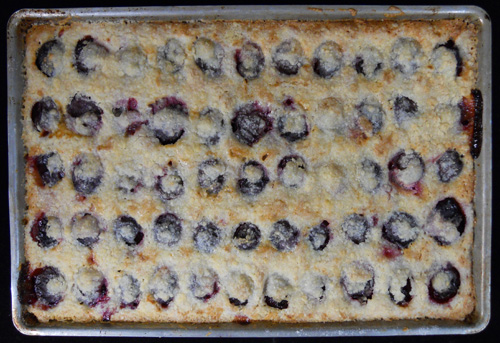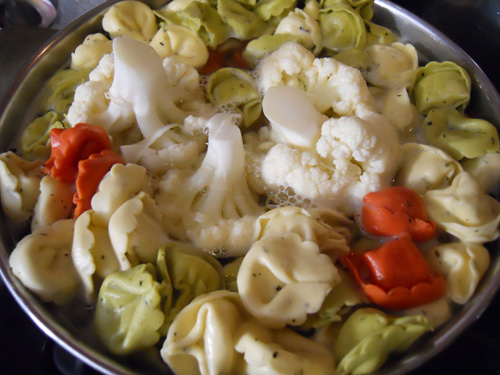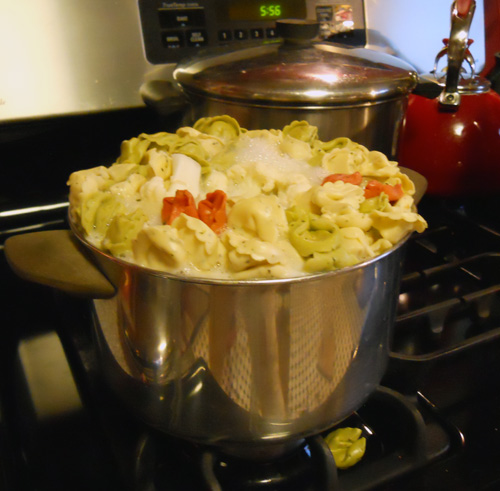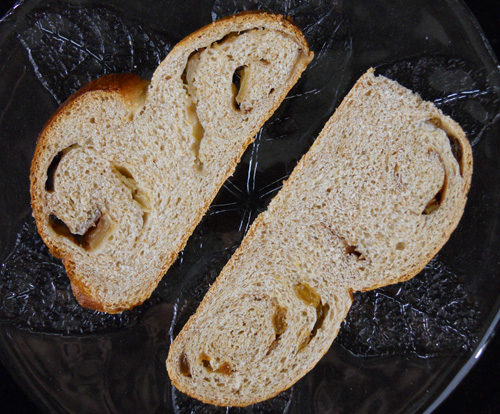
Slices of the round challahs. Apple on the left; raisin on the right.
Last night as I said kaddish for my dad during the Kol Nidre service, I remembered all of the times I sat next to him and my grandfather as they stood in temple to say kaddish for their parents. The melodic cadence of the prayer was effortlessly recited by them both. But in that Reform temple of my childhood only the men said kaddish—a throw-back to more traditional practices. In my current, more traditional yet also more modern congregation, everyone recites the prayer, and I’ve been practicing for the past few years knowing that at any time it might be my turn, and I did not want to disappoint. There was no way to anticipate how emotional that moment would be for me.
My father died three weeks ago. Yesterday, before going to temple, I felt like baking again. And how fitting that the first thing I baked since his death were the holiday challahs, round to symbolize the circle of life and the cycle of the seasons; extra sweet so that we’ll all have a sweet year.
The round challahs are unique to both of the high holidays: Rosh Hashana and Yom Kippur. Our local Jewish Federation has a group that does outreach programs for the seniors in our community. Over the years I’ve been asked to bake dozens of very small, individual, round challahs to contribute to one of their outreach programs. For Chanukah, Purim and the High Holidays they distribute little gift bags to Jewish elderly shut-ins around town, and when my father first moved in with us two years ago, he began receiving these bags. At first I thought it was a silly gesture, after all, my dad had the real thing, right here in our home! He didn’t need the little hamentaschen, or the tiny challahs—mine were baked for him fresh! But to my surprise he loved the bags. He happily showed the contents to me when I got home from work, and he took great pleasure in having little candies of his own that he could share with my children. For Rosh Hashana he would receive a small bottle of grape juice, applesauce, honey, a small round challah, some chocolates, some raisins and a one-page summary of the holiday which he would read carefully with his magnifying glass. What a lovely mitzvah (good deed) this is!
Ten days ago, right before Rosh Hashana I was surprised by a gift bag which was brought to me by Lee, the former director of our local Jewish federation. She brought me a giant version of the bag that they make for the seniors, with enough of everything to feed all five of us, including a full-sized challah, made fresh that morning by Lee herself. She said that she felt funny bringing a challah to the challah baker, but my heart was not in baking that week, and her gift couldn’t have been more appropriate. I was so moved by that gift.

For the raisin bread, drizzle on some honey, sprinkle on raisins and cinammon.

Arrange a thin layer of apples for the apple bread. Or grate an apple and wring out the juice before spreading over the dough.
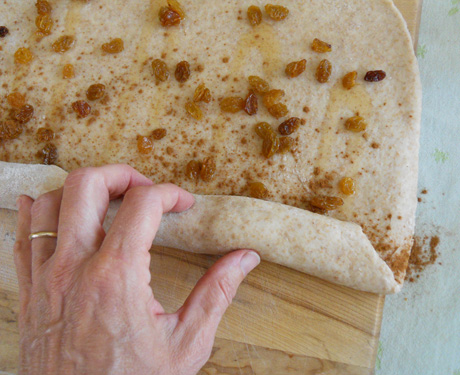
Roll it up. Use both hands and work evenly across the length.
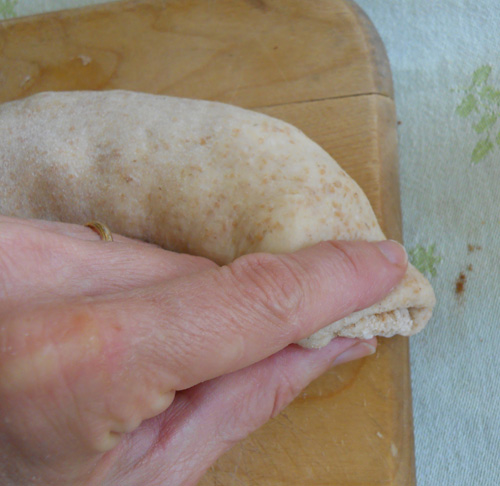
Pinch the ends.

Make the coil. Place it seam side down, and tuck under the end.

Here the coils are ready to rise. They can sit together like this on the same baking sheet. It’s okay if they kiss a little when they bake!

Here are the just-baked breads. It’s okay if they come together while baking. Just gently pull them apart.

Here’s Macey in his favorite chair, hoping for a hot plate on the dinner table and a taste of some hot, fresh challah.
Ingredients
For the dough:
- 1 package yeast (2¼ tsp.)
- 2/3 c. sugar
- 2 c. warm water
- 1 egg
- 3 Tbs. oil
- 1 Tbs. salt
- 2 c. whole wheat flour
- 4 c. (about) white flour
Mix together and brush on before baking:
Sprinkle with:
- sunflower, poppy and/or sesame seeds, about ¼ cup total
Directions
- Proof the yeast: Mix together the yeast and sugar, add the warm water, stir, and let it sit for 20 minutes. It should get foamy.
- Add the rest of the dough ingredients, putting in just enough white flour to make a smooth, not sticky dough.
Knead for about 10 minutes.
- Cover and let rise for about 3 hours, or until doubled in size. Shape into two small loaves or one large loaf. Place loaves on a greased cookie sheet or into greased loaf pans if you want sandwich-shaped loaves. Cover and let rise for one more hour.
- Brush with the egg/honey mixture and sprinkle with some seeds. Bake at 350˚ for 35–40 minutes. (Add 5–10 more minutes for a challah that’s stuffed and rolled, covering with foil for the last 15 minutes to prevent the top from burning.)
You can find more tasty bakes in my newly released cookbooks:
You Can’t Have Dry Coffee: Papa’s Excuse to Have a Nosh And Nana’s Perfect Pastries
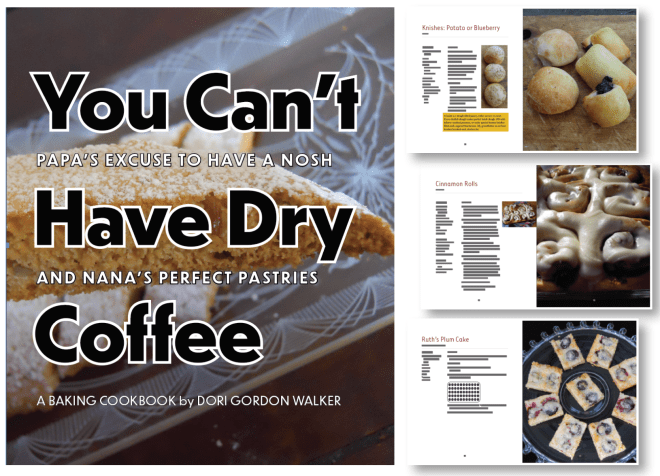
“You can’t have dry coffee,” was what my grandfather would say when reaching for one of my grandmother’s delicious cookies or pastries. Elegant rugelach and mandel bread, tart plum cake, delicate cream cheese cookies, and sweet babka—these fancy treats started me on my life-long love of baking. Along with those classics, this collection has challahs, bagels, bialys, plus modern-day luscious treats like chocolate cream cheese brownies, and the best chewy, peanut butter chocolate cookies I’ve ever had.Whether my grandfather was being ironic, or if something was lost in translation from Yiddish, I’ll never know. But ironic or not, a cup of coffee needs a good nosh, and this book is a compilation of our family’s best.
The Plate is My Canvas: Recipes and Stories from My Family’s Interfaith Kitchen

Written in the style of a family memoir, with stories from my family, this book includes all of the Jewish classics, from rugelach to latkes. Married to a Lutheran man, I learned to cook my husband’s family’s classics as well—with help from my mother-in-law’s handwritten recipes. Stunning photographs accompany each recipe. A perfect gift for an interfaith family.

